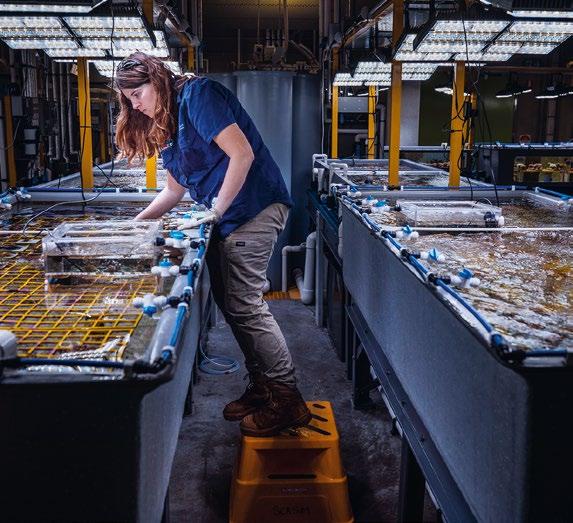
10 minute read
Reef Challenge
THE REEF CHALLENGE
Mass outbreaks of starfish, pollution from agriculture and a hotter sea leading to coral bleaching – The Great Barrier Reef has long been subject to a number of problems that threaten its existence. Now a series of efforts are aimed at reversing the trend.
Advertisement
BY JOHAN AUGUSTIN PHOTO JONAS GRATZER
Blacktip reef sharks circle around some green sea turtles that feed on algae on the corals. Stingrays brush past along the sandy bottom. Suddenly, a few dolphins join in, looking to hunt with the reef sharks. We dive near the coral reef that surrounds Lady Elliot Island, a small island at the southern tip of the Great Barrier Reef, in Queensland, Australia. It’s easy to understand why the area is world-famous among divers. But the fantastic underwater scenes are giving us mixed emotions. How long are they going to be around for?
The northern – and warmer – parts of the Great Barrier Reef are now known for completely different things. As the water temperature rises, the corals’ defenses are adversely affected. The corals, which are living organisms, can end up dying as a result. The phenomenon is more commonly known as coral bleaching. The mass die-offs that hit the northern areas in 2016 became international news, and the following year was just as bad.
Warming periods becoming more frequent Reports on how much of the whole barrier reef has been affected by coral bleaching vary. However, at least half of the corals in the areas examined are estimated to have been bleached and are either partially dead or completely dead.
Coral bleaching is not a new phenomenon. In the past, severe bleaching has occurred approximately every thirty years. Since the 1980s, the frequency has increased to once every six years. And in 2016 and 2017, bleaching occurred two years in a row.
Usually it takes at least ten years for the corals to recover, but if the bleaching occurs at shorter and shorter intervals, then it becomes difficult for the corals to rebound.
Global sea temperatures have risen throughout the course of history, and the coral reefs have survived. But in the past, changes occurred over long periods of time. Never before has the bleaching occurred as quickly as is currently happening. Now the researchers are asking: Can technical assistance contribute to rescuing the world’s coral reefs?
Super corals occupy the reef The Australian Institute of Marine Science (AIMS) is located outside of Townsville in the north of Queensland. Here, researchers are investigating how so-called “super corals” – corals that can withstand higher water temperatures – could be distributed over large areas. Inside AIMS, around 25 strains of corals are being crossbred in a sea simulator, which is considered the world’s most advanced research aquarium. Species from the northern parts of the reef are being mixed with from those from the colder central and southern parts of the reef. “It’s like crossbreeding corn. We are doing the same with the corals so that they can withstand higher temperatures,” says Kate Quigley, a researcher in reef restoration.
The method is called assisted gene flow and is still in its infancy; however, it’s already showing positive results in the sea simulator as well as on the reef where cross-bred corals have been placed in coral cultures.
In order for the super corals to have an effect on the Great Barrier Reef – which is approximately 1,400 miles (2,300 kilometers) long – it is necessary to spread the corals over large areas while they are still in the larval stage. The larvae grow in cages and are then placed in strategic locations. Kate Quigley and her colleagues hope that within three years it will be possible to spread hundreds of thousands of individual farmed corals over reefs that have been affected by bleaching.
At the same time, climate change is hanging like a dark cloud over their progress.
“Hundreds of studies have been conducted that show that climate change is the greatest threat to the reef,” says Kate, but at the same time, she clarifies that the global fluctuations look different.
The enemy of my enemy... AIMS is also researching ways to reduce the number of crown-of-thorns sea stars – a starfish whose quantities have exploded in certain parts of the reef. To date, divers have injected the crown-of-thorns sea stars with vinegar – a method that kills the starfish. Now researchers at AIMS are working on how a natural enemy to the Lady Elliot Island is working on a number of projects to ensure the survival of the reef. The island processes all wastewater and prevents runoff from reaching the reef, recycles plastic and is replanting native trees and plants that prevent erosion.



crown-of-thorns sea stars – the rare Giant Triton snail – might be deployed and proliferate in areas it has disappeared from. The giant snail is highly sought for its shell, and as a result, its stocks have been depleted in many places – another reason why the crown-of-thorns sea stars have been able to grow in number unimpeded, in turn upsetting the natural balance. Agriculture as another cause? Over the years, much of the coral die-offs on the Great Barrier Reef – particularly in the media – have been blamed on Queensland farmers who, through their farming practices, are said to have caused large amounts of nutrients, such as phosphorus, to leak onto the reef. This in turn causes algae blooms that cover the corals.
Recently, attitudes have changed among many of the Queensland farmers and they now want to develop more sustainable farming practices. Thousands of farmers and livestock breeders are involved in projects that are aimed at reducing sediment, nutrients and insecticides in wastewater.
Gary Spotswood is a third-generation farmer at Mt Alma Organics, an organic farm just over an hour outside of Townsville. On his farm, he has installed, among other things, pumps to capture wastewater, which is then filtered naturally through wetlands that cover part of the land. The results can already be seen. A lagoon spreads out next to a field of sugarcane. Suffocating weeds had previously covered the water, says Gary Spotswood. These days, it’s clear and free of weeds. When the sea water temperature rises by 1-2°C above normal, the algae become toxic to the corals, which then get rid of them. The white skeletons of the corals then become visible, resulting in the bleaching. To the right: Samantha Jaworski, researcher at AIMS.
We need to change our behavior Gary Spotswood also holds courses in land use for other farmers in the area. Artificial fertilizers are expensive and price is another reason why many farmers want to switch to more sustainable alternatives. According to Gary Spotswood, the best alternative for the area’s dry lands is supposedly a mixture of the residues from sugarcane and compost from aquatic plants. The mixture binds to the carbon and nitrogen in the soil and the nutrition stays in the soil longer while water is simultaneously retained in the plants’ root systems. “Changes take time but in five years, people have changed their habits in how they use the soil. It’s a win-win because in the end, it’s also about being cost-effective.”
But despite improvements in the area’s agriculture, Gary thinks there is another, much more important issue that the world should be acting on. “Climate change is by far the biggest threat to the reef’s survival.”
The coral reef is usually called the sea’s rainforest due to its enormous biodiversity. Corals are animals that live in symbiosis with single-celled algae, which live inside the corals and give the corals their color. The algae feed the corals through their photosynthesis and in return, the algae receive protection and nitrogen from the corals. It takes between five and twenty years for a coral reef to rebound, provided that the bleaching does not occur at regular intervals. Other threats to the reef include cyclones and the crown-of-thorns sea stars. The Great Barrier Reef extends approximately 1,400 miles (2,300 kilometers) along Australia’s northeastern coast. It is one of the world’s most biodiverse areas and contains more than 600 species of coral and 1600 species of fish. It is also important for Australia’s economy: Tourism generates US $4.2 billion annually and is responsible for 64,000 jobs. THE SEA’S RAINFORESTS
Consistent Results. Worldwide.
Textile testing from Bönnigheim to New Delhi, Dhaka to Hong Kong.
When you ask Hohenstein to test textiles, you do more than bring in expertise. You also tap into the reputation of a globally recognised company – a partner who joins you in making the future more sustainable. Benefit from the quality we offer, driven by the same high standards, worldwide.
Scan and watch the Hohenstein labs in action.
With its odor-eliminating and warm-when-it’s-cool and cool-when-it’s-warm properties, wool cotinues to impress new targets.



The International Wool Textile Organisation’s Dalena White outlines wool’s sustainability credentials at every stage of the product life cycle. Wool – Natural, Circular Sustainability
Among the many benefits of using wool, its sustainability is one of the most compelling. Meanwhile, its performance characteristics during use are such that woollen garments should surely be high on a wish list for any active person. This combination clearly sets wool apart from the competition making this fiber, which has been used for thousands of years by humans, more relevant now than ever. But in an era during which manufacturers and consumers are being overwhelmed with claims and counter claims about performance and sustainability, how do we cut through the myriad of available information? In short, the answer is that we must use facts and figures to target the right audiences with the most relevant information and make a clear and scientifically proven case for wool. The good news is that this work is already well underway.
Our industry has recently got off the starting blocks to champion wool as a great material for runners and outdoor enthusiasts, during both activity and at rest. New research by Raechel M. Laing at the University of Otago in New Zealand showed that wool, overwhelmingly more than any other fiber type, has the attribute of odor resistance.
This is a triple win: It’s a win for sustainability, because wool has to be washed less often, using less detergent and water; it’s a win for wellness because of the full package of performance benefits - odor resistance, plus breathability, warm-when-it’s-cool-and-cool-whenit’s-warm properties, and comfort next to the skin of superfine Merino garments; and it’s a win for people who love the outdoors, because wool not only performs, it also lasts and looks great. This can resonate on multiple fronts and our messages are starting to gain traction in a greater range of relevant target media, such as Runner’s World.
Naturally long lifespan Durability – or longevity – is a particular area where using wool represents a big net positive in sustainability terms. Whichever way you approach the subject, it’s clear that wool is a sustainable choice. Well-made woollen garments last, so in simple terms they don’t have to be replaced as often. As I have already noted, they have to be washed less often, which itself extends product life and uses fewer resources in the process. Looking at sustainability from a different perspective, if wool returns to the ecosystem after the end of life of a garment, it’s a natural fibre that will biodegrade. This is in sharp contrast to synthetic materials.
These are areas where wool’s sustainability really shines through and that is characterised by clear and well-established circularity: Sheep turn grass into wool, we harvest it once a year, it grows back; wool is fashioned into garments, garments are used until they are worn out, the wool can return to the ecosystem, which can then produce more material. That’s how humans have interacted with wool for millennia. Of course, there are more factors involved today, but the fundamental circular economy that wool offers is the same as ever – reliable, robust and renewable. Now add the material’s other properties to the mix, and woollen garments really hit the sweet spot, as both the best choice for active, healthy living, and the most comprehensive sustainable purchase options. For many years, the International Wool Textile Organisation has been leading the way in establishing a solid portfolio of scientific evidence about the sustainability of wool and since 2011, our members have collectively contributed more than €560,000 to this work. Those efforts have been substantial and the results are now delivering the robust, significant data that reinforces our sector’s position as a champion of sustainability, and which we are communicating in a more strategic and impactful way than we have ever done before.
Dalena White is the Secretary General of IWTO, the authority for standards in the wool industry.








